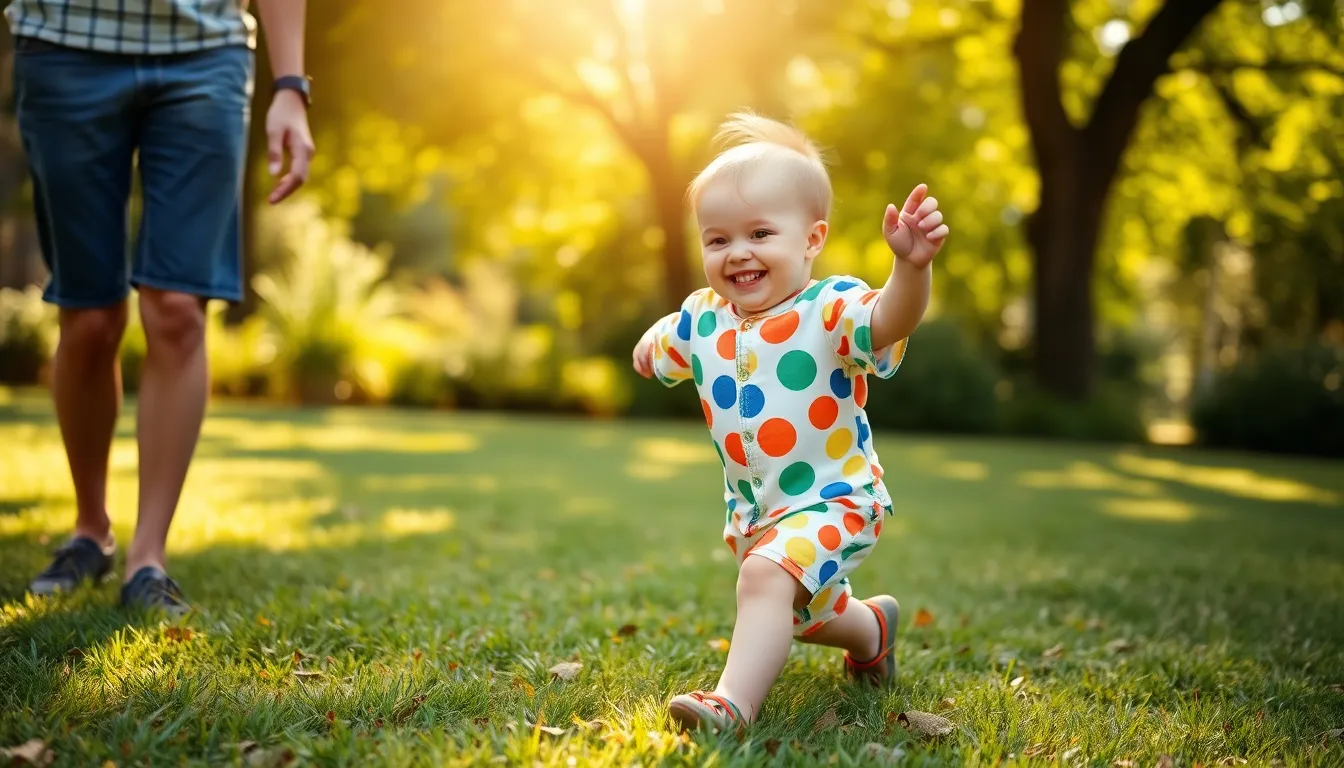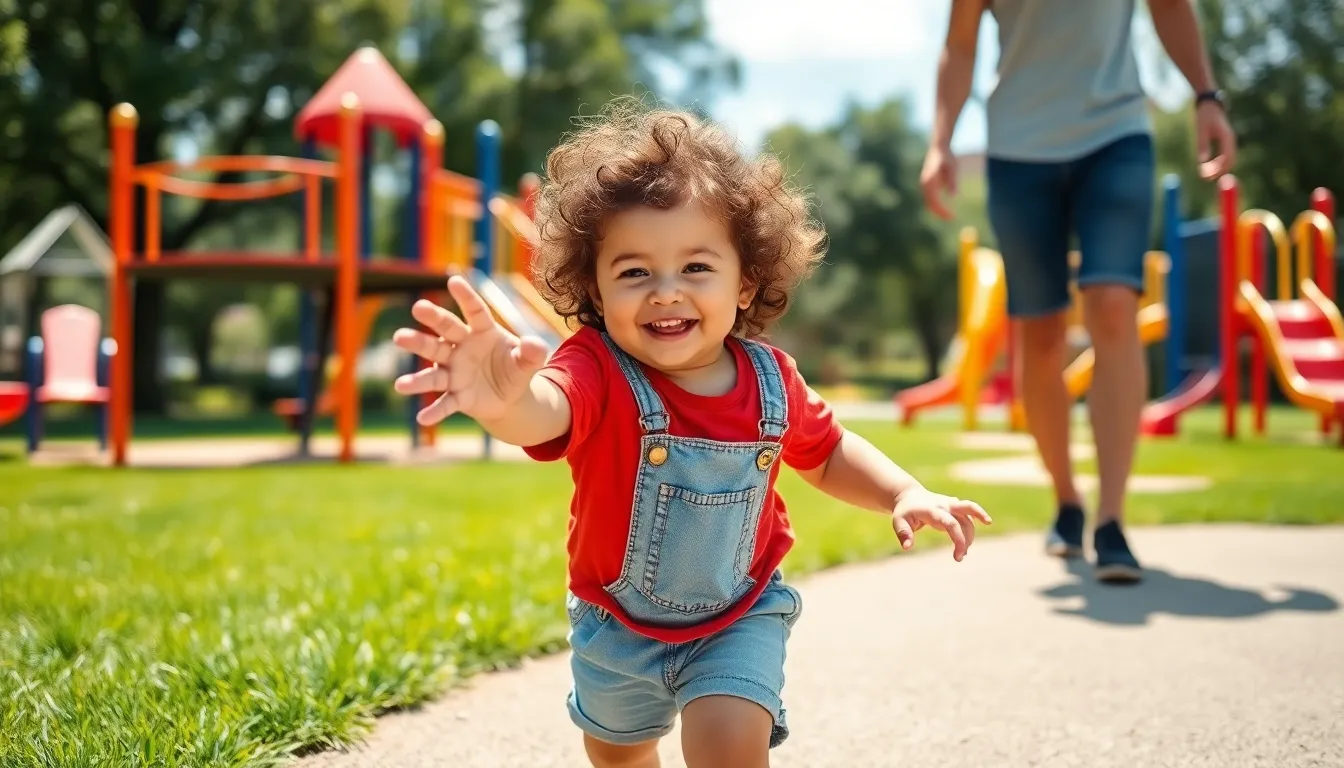Imagine a world where toddlers, armed with tiny feet and boundless curiosity, take their first wobbly steps. It’s not just a milestone in mobility; it’s a leap into a universe of communication. As they navigate their surroundings, these pint-sized explorers are also laying the groundwork for language development in ways that might surprise you.
Walking opens up a treasure trove of experiences, sparking interactions with parents, peers, and the environment. Each step taken is a word spoken, each tumble a lesson learned. So, how does this newfound mobility turn into a linguistic powerhouse? Let’s dive into the delightful dance between walking and talking, where every giggle and stumble contributes to a child’s growing vocabulary and understanding of the world around them.
Table of Contents
ToggleUnderstanding the Connection Between Walking and Language
Walking plays a crucial role in toddlers’ language development. This milestone facilitates new interactions that significantly boost communication skills.
The Role of Motor Skills in Development
Motor skills enhance various developmental areas, including language. As children develop balance, coordination, and strength, they gain confidence in navigating their surroundings. Successful mobility encourages exploration, leading to diverse experiences. These experiences become opportunities for toddlers to engage with caregivers and peers. Talking during play helps them associate words with actions and objects. Motor skills create a bridge, connecting physical movement to verbal expression.
The Importance of Physical Exploration
Physical exploration serves as a vital component in language growth. When children walk, they discover environments filled with new sights and sounds. Each exploration sparks curiosity and prompts questions, fostering verbal interactions. Engaging with different textures, shapes, and colors enables children to expand their vocabulary. Opportunities to imitate sounds and words naturally arise during playtime. Such interactions promote language comprehension and communication skills. Frequent exploration encourages children to express their observations, facilitating language expansion.
Cognitive Development and Language Acquisition

Cognitive development significantly influences language acquisition. As toddlers learn to walk, they experience active learning opportunities that enhance their understanding and communication skills.
The Impact of Active Learning
Active learning results from exploration and interaction. Engaging with the environment fosters curiosity, prompting toddlers to ask questions and express thoughts. Each new experience can lead to the introduction of new words. Playing with different objects and interacting with caregivers encourages verbal communication, which strengthens vocabulary. Repetitive actions, like walking towards a parent, provide chances for toddlers to practice language skills, reinforcing comprehension. Shared moments during exploration create connections, supporting both cognitive and language growth.
How Movement Enhances Brain Function
Movement stimulates various brain regions. Engaging in walking encourages neural connections essential for language development. Physical activity increases blood flow to the brain, promoting cognitive functions. Each step taken enhances coordination and balance, which contributes to increased confidence. As toddlers navigate their surroundings, they acquire spatial awareness, crucial for understanding language. Enhanced motor skills lead to a more interactive exploration process, ensuring children make meaningful connections between words and their meanings in real-life contexts. Every movement serves as a building block for rich linguistic development.
Social Interaction Through Walking
Walking encourages toddlers to interact socially, significantly impacting language development. These newfound abilities lead to more frequent engagement with peers and caregivers.
Encouraging Communication and Expression
Toddler mobility enhances verbal communication. As children walk, they often initiate conversations with those around them, expressing needs and desires. Words become tools for sharing experiences, prompting caregivers to respond and expand dialogue. When toddlers realize they can communicate actively, their confidence grows, leading to richer vocabulary. Verbal exchanges during play foster an environment where children learn to articulate thoughts clearly.
Shared Experiences and Language Use
Shared experiences during walking create opportunities for language use. Engaging in activities like exploring parks or playing chase strengthens bonds with peers. These interactions improve children’s understanding of language within context, as they associate specific words with actions or objects. Joint play inspires questions, leading to discussions that enhance language skills. When brothers, sisters, or friends walk together, they share laughter and stories, making memories that reinforce their communicative abilities.
Case Studies and Research Findings
Research indicates a strong connection between achieving mobility and advancements in language skills. Exploring various child development studies sheds light on this important relationship.
Evidence from Child Development Studies
Numerous studies demonstrate that walking correlates with language development milestones. For example, children who walk earlier often exhibit larger vocabularies compared to their peers. Observations suggest that those who engage more with their environment tend to use more complex language structures. The act of exploring promotes opportunities to encounter new words in context. Additionally, the American Academy of Pediatrics emphasizes physical activity’s role in cognitive and language growth. Walking also enhances social interactions, allowing toddlers to mimic language patterns observed in their surroundings. Through these experiences, meaningful connections form between words and actions, fostering overall communication skills.
Observations of Milestones in Children’s Growth
Tracking milestones provides insights into children’s development patterns. Parents often note that verbal expressions increase significantly around the time of walking. As toddlers gain mobility, they engage more in conversations and initiate interactions with caregivers. Milestones observed during play also highlight the concurrent growth in physical and language skills. Children demonstrate a better understanding of language by associating movements with verbal cues. New experiences related to walking, such as exploring parks, encourage questions and discussions. Thus, these observations reinforce the idea that physical milestones directly impact language acquisition. Every step taken invites opportunities for learning, enriching vocabulary and communicative abilities.
Practical Implications for Parents and Educators
Encouraging mobility in toddlers plays a vital role in their language development. Parents should create an environment that promotes walking and exploration. Safe spaces for toddlers to practice movement lead to more opportunities for verbal interactions. When children navigate their surroundings, they engage with peers and caregivers, enhancing vocabulary through real-world experiences.
Educators can incorporate activities that encourage physical engagement, integrating movement with language learning. For instance, interactive games that require walking stimulate both physical and linguistic skills. Children who explore playgrounds or engage in group activities often initiate conversations, expressing their thoughts more confidently. These conversations facilitate richer vocabulary and communication proficiency.
Supporting toddlers’ walking milestones can also enhance cognitive functions, directly impacting language acquisition. Parents can promote discussions during walks, asking open-ended questions about their environment. Educators should emphasize group activities where children can practice using new words learned through exploration. Repetition in language use during play reinforces comprehension and enhances communication skills.
Providing feedback during these interactions is crucial. Highlighting correct language use and offering new vocabulary fosters a supportive learning environment. Caregivers can model language patterns in natural conversations, allowing toddlers to mirror these patterns in their speech.
Finally, continual observation of language milestones is essential. Tracking verbal expressions around walking achievements can provide insight into a child’s development. Recognizing that walking encourages social interaction enables parents and educators to prioritize physical activity as a core component of language growth.
Learning to walk is more than just a physical milestone for toddlers; it’s a gateway to enhanced language development. Each step taken fosters social interaction and verbal communication, enriching vocabulary and confidence. As children explore their surroundings, they engage in meaningful conversations that deepen their understanding of language.
The interplay between mobility and communication skills underscores the importance of encouraging walking in early childhood. By creating environments that promote exploration and interaction, parents and educators can significantly impact a child’s linguistic growth. Observing these milestones can provide valuable insights into a child’s development, reinforcing the idea that each movement is a crucial building block for effective communication.





